Flystrike in Chickens: Causes, Prevention and Cures
Ever seen a horror movie where the antagonist is something you least expect? Flystrike in chickens is kind of like that. It’s a condition where flies lay their eggs on your chickens, and those eggs turn into maggots which eat away at your chicken’s flesh. Yup, pretty horrific.
Causes of Flystrike in Chickens
Flystrike, while a grim topic, is essential for chicken keepers to fully comprehend. Understanding its causes can be the first step in effective prevention. Let’s delve deeper into the primary culprits.
1. Wounds or Open Sores
Have you ever noticed how a minor cut or scrape on your body seems to be a magnet for those pesky flies? Chickens are no different. Open wounds or sores release bodily fluids like blood or pus, which have a distinct odor. Flies have a remarkable sense of smell and are naturally attracted to these odors.
Aside from the immediate pain or discomfort a wound might cause the chicken, the wound becomes a breeding ground when flies lay their eggs there. As these eggs hatch, the maggots begin feeding on the chicken’s flesh, aggravating the wound and causing further distress.
2. Dirty Coops
A dirty coop isn’t just an eyesore; it’s a playground for flies. Leftover food, droppings, and wet bedding are all components of a chaotic coop environment.
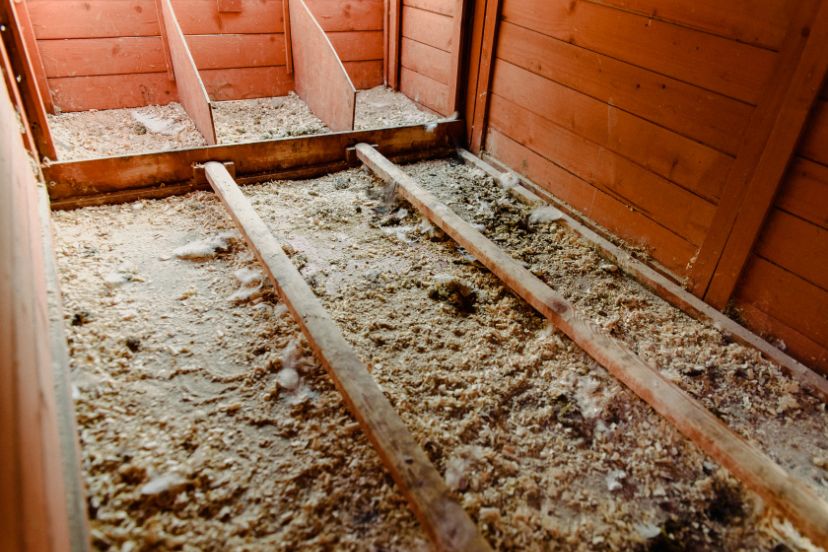
Flies thrive in places where they can feed and reproduce. A coop filled with organic matter like droppings provides ample nourishment. Moreover, such messy conditions are also ideal for laying eggs, ensuring a new generation of flies ready to torment your chickens.
Read our article Backyard Chicken Coops: All You Need to Know for more information.
3. Damp and Warm Conditions
While chickens love sunbathing on a warm day, the combination of heat and moisture can quickly turn their coop into a hotspot for fly infestations.
Warmth accelerates the lifecycle of flies. A damp environment, especially combined with organic matter like droppings or leftover food, becomes a suitable medium for flies to lay eggs. In these conditions, eggs hatch quicker, leading to a rapid increase in the fly population.
More flies mean a higher risk of Flystrike in chickens. Each fly is on the lookout for a suitable spot to lay its eggs, and with a horde of them buzzing around, it’s just a matter of time before one finds an unsuspecting chicken to victimize.
Symptoms and Identification
Awareness and timely intervention are crucial when it comes to the health and well-being of our feathered friends. Like many ailments, Flystrike in chickens has its set of early warning signs. Recognizing these symptoms can be the difference between a healthy chicken and a distressed one. Let’s dive deeper into understanding these indicators:
1. Lethargy in Your Chicken
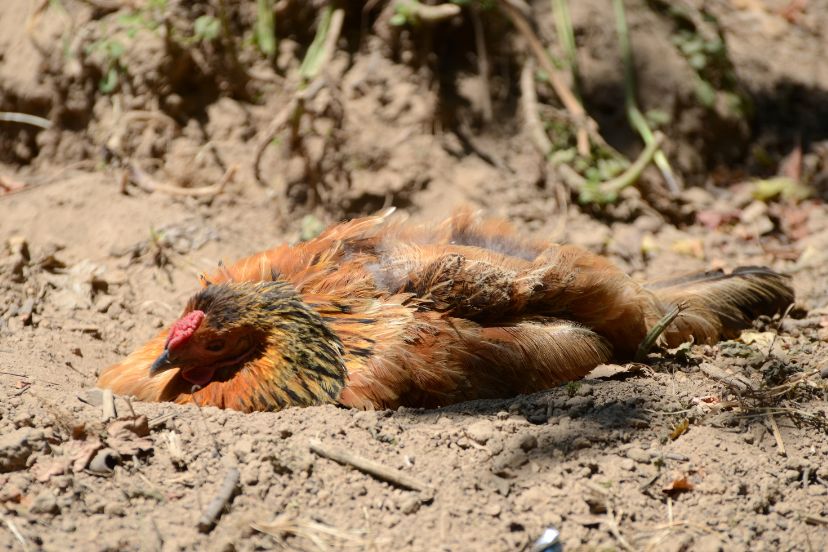
When your once lively and active chicken starts to act sluggish, moving less, or not showing interest in its usual activities, it’s a cause for concern. Lethargy is often an indication that the chicken is not feeling well.
As the maggots begin to infest and feed on the chicken’s flesh, it causes discomfort and pain. The chicken’s body also starts to fight off the infection, leading to fatigue. Consequently, the chicken conserves energy by becoming less active.
Observation Tips: Always be vigilant about your chicken’s energy levels. A sudden change in behavior, like reduced pecking, decreased movement, or lack of interest in food, can signal underlying issues like Flystrike.
2. Foul Odor Emanating from Them
Flystrike leads to tissue damage. As maggots consume the chicken’s flesh, the affected areas begin to rot, producing a distinct, unpleasant smell.
While it might be uncomfortable to sniff around your chicken, being familiar with the natural odor of your coop and your chickens can help you quickly detect any abnormalities. A foul odor is a clear indication of an infection or decay.
Pro Tip: Routine checks and getting close to your chicken can make it easier to identify unusual smells. The sooner you detect it, the quicker you can intervene.
3. Visible Maggots or Wounds
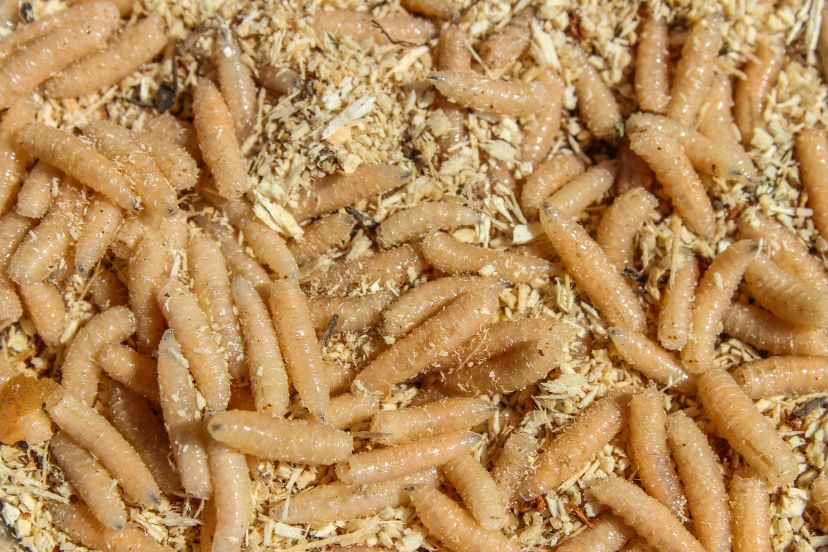
Visible maggots on your chicken’s body are a clear-cut sign of Flystrike. These tiny white creatures might be seen clustered on parts of the chicken’s body, particularly in hidden areas like under the wings or around the vent.
A wound or sore on your chicken’s body, especially one that’s damp or has a discolored discharge, is a prime site for Flystrike. Even if maggots aren’t immediately visible, such wounds should be monitored closely.
Immediate Steps: Upon spotting maggots or suspicious wounds, immediate action is required. Cleaning the affected area and removing any maggots are the first steps to halting the progression of Flystrike.
Prevention Strategies: Knowing the symptoms is essential, but prevention is always better than cure. Keep the coop clean, ensure a balanced diet, and practice regular inspections. By fostering a hygienic environment and keeping a watchful eye, the chances of Flystrike in chickens can be significantly minimized.
Proper Hygiene and Coop Maintenance
When it comes to chicken rearing, one principle stands tall: “A clean coop is a happy coop.” But it’s more than just an adage. Proper hygiene and maintenance of the chicken coop are cornerstones of ensuring your flock’s health, longevity, and productivity. Here’s why it matters and how to ace it:
Hygiene and Health
Disease-causing organisms love damp, dirty environments. By ensuring proper hygiene, you’re essentially cutting off their lifeline. Poor coop hygiene can attract flies, which, as we’ve discussed earlier, can lead to Flystrike in chickens. Moreover, a dirty coop also raises the risk of other diseases like coccidiosis, respiratory problems, and fungal infections. Cleanliness directly correlates with the well-being of your chickens. The cleaner the environment, the lower the chances of diseases.
Coop Cleaning
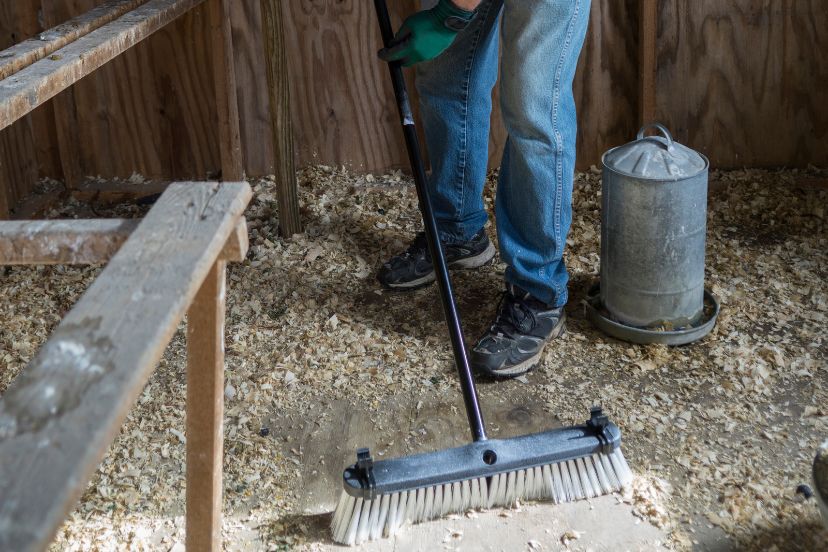
Remove droppings, leftover food, and any wet or soiled bedding daily. Weekly, replace all bedding and clean feeding and watering equipment. Every few months, it’s wise to conduct a thorough cleaning. This involves emptying the coop, scrubbing down surfaces, checking for mold or pest infestations, and then disinfecting.
Ensure the coop is well-ventilated. This helps to keep it dry and reduces the buildup of ammonia from droppings, which can be harmful to chicken respiratory systems.
Coop Maintenance
Apart from cleaning, regularly inspect the coop’s structure. Look out for damages, potential weak spots, or openings that predators could exploit.
Using natural deterrents or safe pesticides (keeping the chickens in mind) can prevent pest infestations, like mites or rats, which can carry diseases. The coop should provide protection against the elements. Ensure that the roofing is intact, walls are sturdy, and any gaps or holes are promptly sealed.
Hygiene Routine
Having dedicated cleaning equipment just for the coop can make the process efficient. Keep brushes, scrapers, natural disinfectants, and gloves ready. Dispose of coop waste appropriately. Composting is an excellent way, but ensure it’s done correctly to kill off pathogens. Chickens love to dust bathe as it helps them get rid of pests. Providing them with a dedicated dust bath area with sand and diatomaceous earth can be an added hygiene measure.
Much like how a well-maintained home ensures our health and safety, a well-kept coop does the same for chickens. It’s an ongoing process and requires diligence. But, the rewards—a thriving, happy flock—are well worth the effort. Remember, with chickens, as with life, prevention through proper care is always better than a cure.
Diet and Water Management
One of the pivotal components of chicken well-being is ensuring they have a balanced diet and access to clean water. When we think about poultry health, it’s easy to envision their physical environment or protection from predators, but the fundamental truth is: their dietary intake plays a significant role in keeping most ailments at bay. Let’s take a closer journey into why and how:
Balanced Diet
Just like humans, chickens require a mix of proteins, vitamins, minerals, and carbohydrates for growth, energy, and overall well-being. An unbalanced diet can lead to various health issues in chickens, one of them being diarrhea. Diarrhea isn’t just messy; it makes the chicken’s vent area damp, which can be a magnet for flies, increasing the risk of Flystrike.
Ensure their feed comprises the right mix of grains, seeds, grit (for digestion), and occasional protein boosts like worms or insects. Greens and kitchen scraps, in moderation, can also be a nutritious addition.
Find out why chickens can eat banana peels, grass, cilantro, and more…
Clean Water
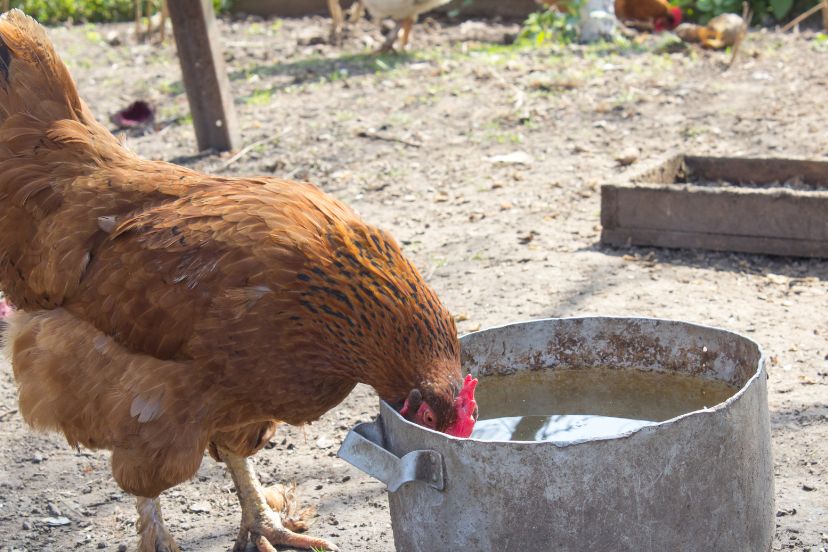
Water is crucial for various physiological processes in chickens, including digestion, temperature regulation, and waste elimination. Dirty water can be a source of pathogens, leading to diseases. Moreover, stale or dirty water can deter chickens from drinking, leading to dehydration.
Ensure that water containers are cleaned and refilled daily. Not just for cleanliness, but fresh water also encourages chickens to drink adequately, ensuring they remain hydrated.
Diet-Water Synergy
A balanced diet aids in proper digestion, and clean water aids in flushing out toxins and assisting in nutrient absorption. Together, they form the bedrock of internal chicken health.
Offering fresh, clean water can aid in the digestion of a balanced diet, preventing the occurrence of diarrhea. Remember, a hydrated chicken on a balanced diet will have healthier digestion and lesser chances of developing diarrhea.
Proactive Measures for Optimal Diet and Water Management:
- Inspect food for mold or any contaminants.
- Store it in a cool, dry place, and ensure it’s used before any expiration date.
- Place water containers in a location where they’re less likely to get contaminated by droppings or dirt.
- Elevated platforms or nipple waterers can be useful.
- Keep an eye on food and water consumption. Sudden changes can indicate health issues or environmental stressors.
Regular Inspections
Just as we periodically get health check-ups or inspect our homes for any necessary repairs, our chickens too deserve and greatly benefit from regular inspections. This proactive approach ensures that issues are caught and addressed early, maintaining the well-being of the flock.
Why and How of Chicken Inspections
Chickens, much like other animals, can be adept at hiding signs of distress or disease. Regular inspections give you an opportunity to catch potential problems before they escalate.
One of the primary reasons for regular checks, especially in warmer months, is to detect Flystrike early on. If maggots are found during an inspection, they can be promptly removed, drastically reducing the risk of a full-blown infestation.
Regularly handle your chickens, gently spreading their feathers, especially around the vent, under wings, and on their undersides. Feel for lumps, look for parasites, and check their skin condition. Their eyes, beak, and legs can also be indicative of their overall health.
Inspection Routine
While the frequency of inspections might vary depending on the chicken’s age, health, and environment, a good rule of thumb is a thorough check at least once a week. Keeping a log of your inspections, noting down observations, can help you track any changes or patterns in chicken health over time.
Environment Control
Flies aren’t just a mere nuisance; they are potential carriers of disease and the primary culprits behind Flystrike in chickens. Thus, environmental control is crucial in any strategy aimed at preventing fly-related problems.
Barriers to Flies

By installing fine mesh or fly screens on coop windows and ventilation points, you create a physical barrier against flies. This ensures good ventilation while keeping the pests out. Ensure that any entry or exit point, especially those near feeding areas or where the chickens rest, is covered.
Fly traps are commercially available and can be placed around the coop. They attract and trap flies, reducing their numbers.
Natural Predators
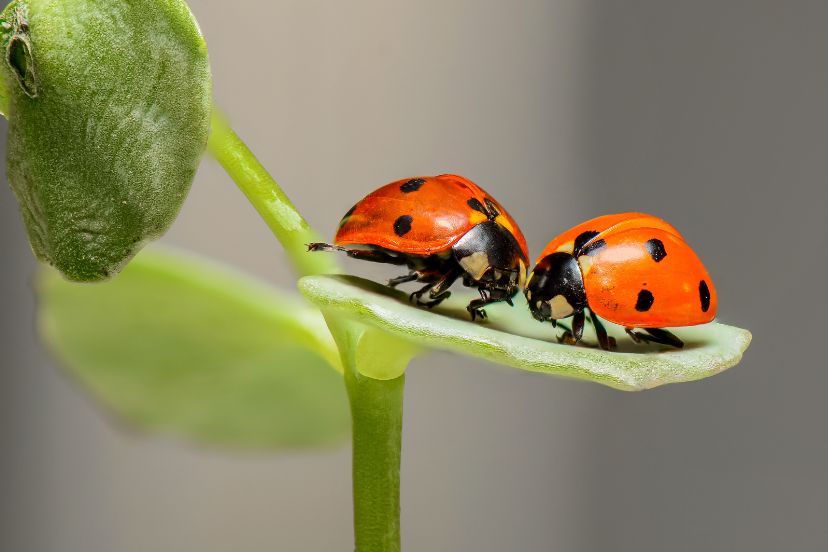
Introducing natural fly predators, like ladybugs or parasitic wasps, can be an organic solution. These beneficial insects feed on fly larvae, naturally controlling the fly population.

Certain plants, like lavender, marigold, and rosemary, act as natural fly repellents. Planting them around your coop can deter flies from setting up shop in the first place.
Treatment Options
Flystrike is one of those ailments that requires quick, decisive action. Discovering that one of your beloved chickens is suffering from it can be alarming, but with the right steps, you can effectively treat the affected bird and prevent further complications.
1. Immediate Steps Upon Identifying Flystrike
Swift Isolation: As soon as you spot a chicken showing signs of Flystrike, it’s imperative to isolate the bird from the rest of the flock. This not only prevents the spread of any potential secondary infections but also offers the affected chicken a stress-free environment to recover.
Gentle Cleaning: Dampness and dirt can further exacerbate the condition. Using lukewarm water, carefully clean the affected area. This action can also make the removal of maggots easier and provide relief to the chicken.
Maggot Removal: This is a crucial step. Armed with a pair of tweezers or gloved hands, methodically remove all visible maggots. Gently and thoroughly ensure you leave no maggots behind. It can be a daunting task, but it’s vital for the chicken’s recovery.
2. Further Treatment and Considerations:
Antiseptic Application: After cleaning and maggot removal, consider applying a mild antiseptic solution to the affected area. This can prevent infections and provide a level of comfort to the chicken.
Veterinary Consultation: If the Flystrike is extensive or if you’re unsure about the complete removal of maggots, it’s wise to consult with a veterinarian. They can provide further treatment options, like antibiotics or pain relief, if necessary.
Nutrition and Hydration: The affected chicken might be in distress and may need additional care in terms of hydration and nutrition. Ensure they have access to fresh water and nutrient-rich food to aid in their recovery.
3. Preventive Measures Post-Treatment:
Monitor the Chicken: Once treated, keep a close eye on the affected chicken for a few days. Check for signs of improvement or any resurgence of maggots.
Evaluate Coop Conditions: Use this as an opportunity to assess and improve the cleanliness and hygiene of the coop. A clean coop is a significant deterrent for flies.
Educate and Inform: If you’re part of a community of chicken keepers, consider sharing your experience. It not only helps in raising awareness but also in gathering more preventive measures from others.
Medications and Natural Remedies
Flystrike in chickens can be distressing for both the chicken and the keeper. While immediate action and manual removal of maggots are crucial, an integrated approach that utilizes both medications and natural remedies can be particularly effective in both treatment and prevention.
- Veterinary Intervention: Always consult with a veterinarian when Flystrike is identified. They can recommend the best course of action, especially when it comes to medication.
- Antibiotics: In some cases, especially if the Flystrike has led to a secondary infection, your vet might prescribe antibiotics. These drugs can help in preventing the spread of the infection and aid in faster recovery.
- Topical Treatments: There are medicated ointments and sprays available that can both treat and prevent Flystrike in chickens. They might contain insecticides that kill maggots and deter flies. But remember, always use them under veterinary guidance.
- Tea Tree Oil: This essential oil is renowned for its antiseptic and insect-repelling properties. When diluted appropriately, it can be applied to the affected area to both soothe the skin and deter flies. However, ensure you do a patch test first, as some birds might be sensitive to it.
- Aloe Vera: Known for its soothing properties, aloe vera gel can be applied to the cleaned and maggot-free area. It provides relief from irritation and promotes healing.
- Lavender Oil: Another essential oil with insect-repellent properties, lavender oil can deter flies when used in the coop. Just like with tea tree oil, ensure it’s diluted and used in moderation.
- Herbal Infusions: Infusions made from herbs like chamomile can be used to clean the affected area. Chamomile, known for its anti-inflammatory properties, can soothe the skin.
Whether it’s medications or natural remedies, always prioritize the chicken’s safety. Avoid overuse and always monitor the bird for any adverse reactions. Even after applying treatments, it’s essential to consistently monitor the chicken. This ensures that the treatment is effective and allows for timely interventions if required.
Seeking Professional Help
Flystrike in chickens is not just a minor inconvenience; it’s a serious condition that can rapidly deteriorate if not addressed promptly. Even the most seasoned chicken keepers can find themselves overwhelmed by its sudden onset and severity. In such moments, turning to professional help becomes paramount. Veterinarians possess the requisite knowledge, experience, and tools to diagnose the extent of the infestation, recommend effective treatments, and provide care guidelines for recovery.
Moreover, a vet can offer insights into preventive measures tailored to your specific environment and flock’s needs, minimizing future risks. The adage “better safe than sorry” rings particularly true in such situations. So, if ever in doubt or if the situation seems to be escalating, remember that seeking professional veterinary assistance isn’t just a prudent choice, it could very well be a life-saving one for your feathered friend.
FAQs
How often should I clean my coop to prevent Flystrike in chickens? Ideally, once a week. But always be on the lookout for damp spots or droppings.
Are certain chicken breeds more susceptible to Flystrike? Not necessarily. It’s more about the environment and health of the chicken.
Can I use commercial fly sprays in the coop? Be cautious. Many contain chemicals harmful to chickens. Always check with a vet.
How fast do maggots appear after flies lay eggs? It can be as quick as 8-12 hours.
Is Flystrike in chickens fatal? If left untreated, yes. But with early detection and treatment, recovery is possible.




